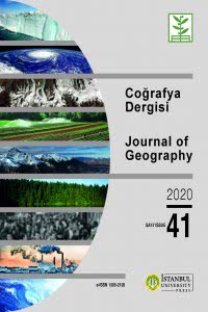DİLUCU SINIR KAPISI’NIN IĞDIR ŞEHRİ ÜZERİNDEKİ ETKİLERİ
1990’ların başlarında Sovyetler Birliği’nin dağılmasıyla birlikte 1991 yılında Azerbaycan bağımsızlığını ilan etmiş; bu süreçte 1921 yılında yapılan Moskova Antlaşması’yla kazandığı özerkliği koruyan Azerbaycan’ın Nahçıvan Özerk Bölgesi Türkiye’yle sınır komşusu olmuştur. 1992 yılında Dilucu Sınır Kapısı’nın açılmasıyla da Türkiye-Nahçıvan arasında bağlantı sağlanmıştır.Dilucu Sınır Kapısı’nın açılmasının yanı sıra Iğdır’ın il olmasının ardından idari açıdan değişmesi, göçler ve sonrasında buna eşlik eden bir dizi gelişmeler, bölgenin ekonomik, sosyal ve kültürel vb. dokusunu büyük ölçüde değişim ve dönüşüme uğratmıştır. Diğer taraftan, Dilucu Sınır Kapısı’ndan sağlanan sınır ticaretiyle yöre halkının refah seviyesi yükselmiştir; ancak gerek Türkiye’nin gerekse Nahçıvan Özerk Bölgesi’nin sınır ticaretine yönelik olarak yaptığı yeni düzenlemeler ve uygulamalar sınır ticareti kazanımlarının uzun soluklu olmasını engellemiştir.Çalışmada Dilucu Sınır Kapısı’nın Iğdır üzerindeki sosyo-ekonomik yapısı ile mekan üzerindeki etkileri incelenmektedir. Çalışmanın veri kaynaklarını bu konuda daha önce yapılmış çeşitli araştırmalardan ve Türkiye İstatistik Kurumu, Dilucu Gümrük ve Gümrük Muhafaza Müdürlüğü, Iğdır Ticaret ve Sanayi Odası ile Iğdır Belediyesi’nden temin edilen bilgiler oluşturmaktadır.Anahtar Sözcükler: Iğdır, Sınır ticareti, Dilucu Sınır Kapısı, Şehirsel kullanım.The Effects of the Dilucu Border Gate on IğdırAbstractAfter the collapse of the Soviet Union in 1991, Azerbaijan declared independence, in the process, Azerbaijan's Nakhchivan Autonomous Region, asserting its autonomy from the Treaty of Moscow in 1921, started to have borders with Turkey. With the opening of the Dilucu Border Gate in 1992, Turkey and Nakhchivan started to have economic and social relations. In addition to the opening of the Dilucu Border Gate, the region of Igdir became a province and the subsequent administrative changes, including the immigration developments that occurred, caused the region to change dramatically. The region's economic, social and cultural elements were greatly affected. On top of this, the cross-border trade made possible by the Dilucu Border Gate improved the standard of life of the local residents. However, due to both the Nakhchivan Autonomous Region’s new restrictions and Turkey’s own new regulations on border trading, long-term gains in the region were prevented.In this study, the socio-economic structure of the Igdir Dilucu Border Gate and its effects on the area are analyzed. A variety of data sources in this study are obtained from the previously conducted research on this issue, as well as from the Turkey Statistical Institute, the Dilucu Directorate of Customs and Customs Enforcement, the Igdir Chamber of Commerce and Industry and the Municipality of Igdir.Keywords: Iğdır, Border trading, The Dilucu Border Gate, Urban use.
After the collapse of the Soviet Union in 1991, Azerbaijan declared independence, in the process, Azerbaijan's Nakhchivan Autonomous Region, asserting its autonomy from the Treaty of Moscow in 1921, started to have borders with Turkey. With the opening of the Dilucu Border Gate in 1992, Turkey and Nakhchivan started to have economic and social relations. In addition to the opening of the Dilucu Border Gate, the region of Igdir became a province and the subsequent administrative changes, including the immigration developments that occurred, caused the region to change dramatically. The region's economic, social and cultural elements were greatly affected. On top of this, the crossborder trade made possible by the Dilucu Border Gate improved the standard of life of the local residents. However, due to both the Nakhchivan Autonomous Region’s new restrictions and Turkey’s own new regulations on border trading, long-term gains in the region were prevented. In this study, the socio-economic structure of the Igdir Dilucu Border Gate and its effects on the area are analyzed. A variety of data sources in this study are obtained from the previously conducted research on this issue, as well as from the Turkey Statistical Institute, the Dilucu Directorate of Customs and Customs Enforcement, the Igdir Chamber of Commerce and Industry and the Municipality of Igdir.
Keywords:
Iğdır, Border trading, The Dilucu Border Gate Urban use.,
___
ACAR, Z, Z., 2010, Her Yönüyle Iğdır, Ankara.CABARZADEDE, M., 2011,“Nahçıvan-Türkiye İktisadi İşbirliği: Durumu ve Perspektif Gelişim Yolları”, Internatıonal Symposium, Regional and Global Dynamics: Economic And Polıtıcal Issues of Turkey and Its Near Abroad, 2011,Genişletilmiş Bildiri Özetleri: 151-152, İzmir.
ÇETİNKAYA, N., 1996, Iğdır Tarihi (Tarih, Yer Adları ve Bazı Oymaklar Üzerine), Türk Dünyası Araştırmaları Vakfı, İstanbul.
DZHABRAILOV, İ,İ,O, 2011, “Regıonal Economıc Polıcy Of Azerbaıjan and Nakhchıvan” Journal of European Economy, Vol. 10, No 4.
KARA,M.,2005, “Ekonomik Etkileri Açısından Türkiye’deki Sınır Ticaretinin Değerlendirilmesi”, Dokuz Eylül Üniversitesi Sosyal Bilimler Enstitüsü Dergisi 3:62.
KOÇMAN, A, İBRAHİMOV, A, ÖNER, E, ÖLGEN, K, IŞIK, Ş, TEMUÇİN, E, SEZER, İ, SOYKAN, F, MUTLUER, M. 1994, Azerbaycan Coğrafyası, Ege Üniversitesi Edebiyat Fakültesi Yayınları, İzmir.
ORHAN, O,Z., 2000, Sınır Ticaretinin Türkiye Ekonomisine Etkileri, İTO Yayınları, İstanbul
ORKUN, V., 1955, Sürmeli Çukuru, Iğdır Tarihi ve Çukuru, Aydın Matbaası, Iğdır.
TAN, M ve ALTUNDAL, F, 2008, Türkiye’de Sınır Ticaretinin Gelişimi ve Mevcut Durumu, İstanbul Ticaret Odası, Yayın No:2008-28, İstanbul.
TÜMERTEKİN, E ve ÖZGÜÇ, N., 2011, Ekonomik Coğrafya Küreselleşme ve Kalkınma, Çantay Kitabevi, İstanbul.
UZUNDERE, A, E,2002,. İnsanlık Suçu; Iğdır ve çevresinde Ermeniler’in Türk Kırımı, Kültür Bakanlığı Yayınları, Ankara.
YULU, A., 2012, Iğdır’da Şehirsel Gelişme ve Mekânsal Değişim, İ.Ü. Sosyal Bilimler Enstitüsü, Yayınlanmamış Yüksek Lisans Tezi, İstanbul.
Iğdır Belediyesi Verileri, 2013.
Iğdır Ticaret ve Sanayi Odası Verileri, 2013.
Türkiye Cumhuriyeti’nin 75.Yılında Iğdır, Iğdır Valiliği, 1998, İstanbul. http://hurarsiv.hurriyet.com.tr/goster/haber.aspx?id=-58705, son erişim 7 Şubat 2013. http://www.nakhchivan.az/portal-en/index-22.htm, son erişim 11 Şubat 2014. http://tuikapp.tuik.gov.tr/adnksdagitapp/adnks.zul son erişim 10 Şubat 2014. http://www.tuik.gov.tr/VeriBilgi.do?alt_id=12, son erişim 2 Mart 2013.
- Yayın Aralığı: Yılda 2 Sayı
- Başlangıç: 1985
- Yayıncı: İstanbul Üniversitesi
Sayıdaki Diğer Makaleler
MARMARA DENİZİ GÜNEYİNDE ÇARDAK - ÇİFTLİKKÖY ARASI YÜKSEK KIYILARIN RÖLYEF ÖZELLİKLERİ
ANAMUR (DRAGON) ÇAYI'NIN (MERSİN) HİDROGRAFİK ÖZELLİKLERİ VE EKONOMİK POTANSİYELİ
ZİRAAT COĞRAFYASI AÇISINDAN BİR İNCELEME: BEKİLLİ’DE (DENİZLİ) BAĞCILIK
